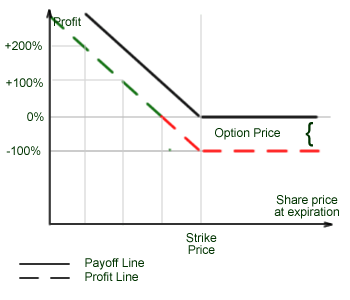Put options (or "puts") give you the right, but not the obligation, to sell an underlying security at a specific price for a fixed period of time. When traders believe an underlying security (e.g., a particular stock or an index) will fall in price, they may buy puts. They must sell an underlying stock before the option expires on a predetermined expiration date, if they wish to sell the security. The premium paid for the option, is the financial risk of buying a put. The premium will be lost (assuming the put option was not sold to another trader prior to expiration), if the option expires worthless. The put buyer can make a profit, if the price of the underlying stock or index moves lower, that is to say, below the strike price.
If you own a put options you can:
Up until a specified expiration date, a put seller, also called the "writer", takes on the obligation of buying an underlying security from the put buyer at a predetermined strike price. By collecting option premium from put buyers, this is how the sellers make money. The put writer keeps the premium if a put expires worthless (i.e., if the put buyer can not exercise the put option at a profit).
Let's assume that current price of a particular stock is $40. Also assume that you buy a put, which give you the right, but not the obligation, to sell the underlying stock to the put writer at a strike price of $36. As long as the put has not yet expired, you have the right to sell the stock at that price, say for three months from today. You paid a premium of $1 per contract (i.e., per 100 shares of the underlying stock), for acquiring this right.
You may choose to exercise your put option, if after some time the stock has declined to $30. The put seller must buy your stock for $36. (You could at this point buy it back for $30, pocketing the difference as your profit). By investing $1 you are making $6 (600%), in this case.
If the stock moves up instead of down, on the other hand, say to $45, your put will expire worthless. You lose the premium you paid for the option while the put seller keeps the premium he or she received from you, in this case.
The same as with call options, a put option ("puts") is a contract between two parties, the buyer and the seller. In opposite to call options, the put options buyer has the right to sell the underlying assets (stock) to the seller of the put option for a certain price (the strike price) and before or at a certain time (the expiration date).
The put options buyer expects the price of the underlying stock to drop in the future but before the options expiration. On the other hand put options seller expects the underlying stock to rise in price or stay at the same price.
The buyer of the put options profits when the underlying stock drops in price and looses when the stock price moves up. The maximum the options buyer can lose is 100% of the premium paid for options. The maximum profit is theoretically unlimited.
The seller of the put options profits when the underlying stock price moves up and the maximum profit is 100% of the premium (when sold options expire worthless). If the stock price drops then the put seller experiences losses and the maximum loss is theoretically unlimited.
The put options are considered in-the money if the current stock price is below the strike price and the put options are considered out-of-the-money if the current stock price is above the strike price. At the expiration the in-the-money options are worthless and out-of-the-money options are profitable.
Chart 1. Buying a put option - the payoffs and profits as seen by the buyer. A lover stock price means a higher profit.
Chart 2. Selling a put option - the payoffs and profits as seen by the buyer. A lover stock price means a higher losses.
A simple example of put options on QQQ stock:
Majority of the options traders do not wait for expiration but rather sell previously bought puts and profit on the difference between the premium paid when puts were bought and premium received when puts were sold. By following the example above:
Naked options trading is very risky - many people lose money trading them. It is recommended contacting your broker or investment professional to find out about trading risk and margin requirements before getting involved into trading uncovered options.